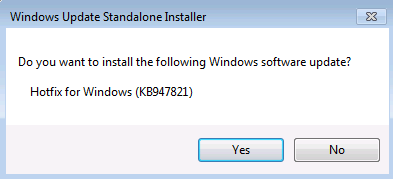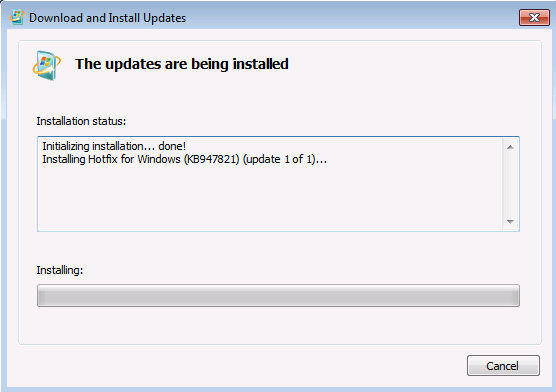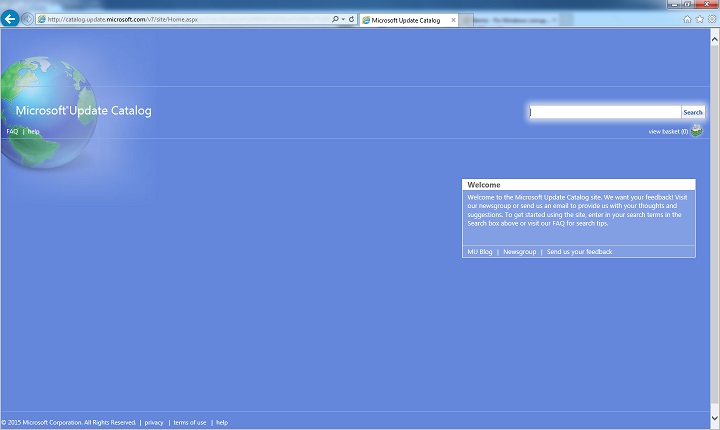- Event log: «Windows detected your registry file is still in use by other applications or services. The file will be unloaded now. The applications or services that hold your registry file may not function properly afterwards».
- Проблема репликации групповых политик (Event ID 13568 Source NtFrs)
- Fix Windows Update errors by using the DISM or System Update Readiness tool
- Symptom
- Resolution for Windows 8.1, Windows 10 and Windows Server 2012 R2
- Resolution for Windows 7 Service Pack 1 (SP1) and Windows Server 2008 R2 SP1
- Resolution — Download the package from Microsoft Update Catalog directly
- Description of the common corruption errors
- What does the System Update Readiness tool do
- Verify the integrity of resources
- Logging
- How to fix errors that are found in the CheckSUR log file
Event log: «Windows detected your registry file is still in use by other applications or services. The file will be unloaded now. The applications or services that hold your registry file may not function properly afterwards».
Original Title: Failed to load profile sometimes (can see all my files in my profile folder, but only installed programs icons show on the desktop, and the wallpaper turned black.)
This problem only occurs on some occasions, have no idea why it happened
- Programs you are having problems with
Warning 9/15/2010 9:48:19 AMUser Profile Service1530None
Log Name: Application
Source: Microsoft-Windows-User Profiles Service
Date: 9/15/2010 9:48:19 AM
Task Category: None
Windows detected your registry file is still in use by other applications or services. The file will be unloaded now. The applications or services that hold your registry file may not function properly afterwards.
1 user registry handles leaked from \Registry\User\S-1-5-21-4010005592-3588851769-3429060209-1005_Classes:
Process 2748 (\Device\HarddiskVolume2\Windows\System32\taskeng.exe) has opened key \REGISTRY\USER\S-1-5-21-4010005592-3588851769-3429060209-1005_CLASSES
1 user registry handles leaked from \Registry\User\S-1-5-21-4010005592-3588851769-3429060209-1005_Classes:
Process 2748 (\Device\HarddiskVolume2\Windows\System32\taskeng.exe) has opened key \REGISTRY\USER\S-1-5-21-4010005592-3588851769-3429060209-1005_CLASSES
- Recent changes you made to your computer
- What you have already tried to fix the problem
- Tried deleting my old profile and start a new one, but same warning occurs, and desktop icons created by user(such as folders, documents) and my wallpaper failed to display, showing the installed program icons and a black wallpaper.
About the event log, please find more information in the Microsoft Knowledge Base article below.
Event ID: 1530 may be logged in the Application log on a Windows 7-based or Windows Vista-based client computer
As per your problem description, it would look like your user profile is corrupted. Please run SFC (System File Checker) scan and verify if there’s any corruption find in system files. If there’s none, you can try Method 2 to fix a corrupted user profile.
Method 1:
This command will immediately initiate the Windows File Protection service to scan all protected files and verify their integrity, replacing any files with which it finds a problem.
Refer this for details.
How to use the System File Checker tool to troubleshoot missing or corrupted system files on Windows Vista or on Windows 7
In case SFC scan doesn’t repair the files, follow the steps given in the link above on how to repair those corrupted files.
Method 2:
Step 1: Create a new user account.
Create a new user account for test purpose.
Refer the steps from the article below to create a new user account.
Step 2:
If Step 1 works, you may follow the steps from the article below to fix the issue.
Fix a corrupted user profile
Shinmila H — Microsoft Support
Visit our Microsoft Answers Feedback Forum and let us know what you think.
Проблема репликации групповых политик (Event ID 13568 Source NtFrs)

Проблема была решена следующим образом:
1. На проблемном контроллере домена в ветке реестра
HKEY_LOCAL_MACHINE\ SYSTEM\ CurrentControlSet\ Services\ NtFrs\ Parameters
создаём параметр « Enable Journal Wrap Automatic Restore » типа REG_DWORD и ему присвоено значение «1»
2. Останавливаем службу FRS ( команда «net stop ntfrs«)
3. Запускаем службу FRS (команда «net start ntfrs«)
4. Убеждаемся, что в логе File Replication Service последовательно зафиксировались события:
Event ID 13553 — The File Replication Service successfully added this computer to the following replica set: «DOMAIN SYSTEM VOLUME (SYSVOL SHARE)»
Event ID 13554 — The File Replication Service successfully added the connections shown below to the replica set: «DOMAIN SYSTEM VOLUME (SYSVOL SHARE)»
..и через некоторое время (когда реплика уже проинициализирована)…
Event ID 13516 — The File Replication Service is no longer preventing the computer MyDC from becoming a domain controller. The system volume has been successfully initialized and the Netlogon service has been notified that the system volume is now ready to be shared as SYSVOL. (the problem is resolved if you receive this event)
5. Далее меняем значение вышеуказанного параметра » Enable Journal Wrap Automatic Restore » с «1» на «0».
6. Выполним команду «net share» чтобы убедиться, что шары Netlogon и Sysvol существуют и доступны.
Вышеописанный метод относится к automatic re-initialization и если он по какой то причине не отрабатывает, то можно воспользоваться форсированным методом переинициализации FRS описанный в статье KB290762 Using the BurFlags registry key to reinitialize File Replication Service replica sets
Суть его сводится к изменению параметра BurFlags в ветке реестра
HKEY_LOCAL_MACHINE\SYSTEM\CurrentControlSet\Services\NtFrs\Parameters\Backup/Restore/Process at Startup в значение “D2” или “D4” (Hexadecimal) с последующим перезапуском службы FRS
D2 – в случае восстановления SYSVOL на одном из упавших DC (когда есть живая рабочая реплика на любом другом DC)
D4 — в случае полного коллапса (выбираем один контролер как эталон и запускаем переинициализацию, на остальных надо запускать D2)Дополнительные источники информации:
Fix Windows Update errors by using the DISM or System Update Readiness tool
Original product version: В Windows 10, version 1809 and later versions, Windows 8.1, Windows Server 2012 R2, Windows 7 Service Pack 1, Windows Server 2008 R2 Service Pack 1
Original KB number: В 947821
Symptom
Windows updates and service packs may fail to install if there are corruption errors. For example, an update might not install if a system file is damaged. The DISM or System Update Readiness tool may help you to fix some Windows corruption errors.
This article is intended for Support agents and IT professionals. If you are home users and looking for more information about fixing Windows update errors, see Fix Windows Update errors.
Resolution for Windows 8.1, Windows 10 and Windows Server 2012 R2
To resolve this problem, use the inbox Deployment Image Servicing and Management (DISM) tool. Then, install the Windows update or service pack again.
Open an elevated command prompt. To do this, open Start menu or Start screen, type Command Prompt, right-select Command Prompt, and then select Run as administrator. If you are prompted for an administrator password or for a confirmation, type the password, or select Allow.
Type the following command, and then press Enter. It may take several minutes for the command operation to be completed.
When you run this command, DISM uses Windows Update to provide the files that are required to fix corruptions. However, if your Windows Update client is already broken, use a running Windows installation as the repair source, or use a Windows side-by-side folder from a network share or from a removable media, such as the Windows DVD, as the source of the files. To do this, run the following command instead:
Replace the C:\RepairSource\Windows placeholder with the location of your repair source. For more information about using the DISM tool to repair Windows, reference Repair a Windows Image.
Type the sfc /scannow command and press Enter. It may take several minutes for the command operation to be completed.
Close the command prompt, and then run Windows Update again.
DISM creates a log file (%windir%/Logs/CBS/CBS.log) that captures any issues that the tool found or fixed. %windir% is the folder in which Windows is installed. For example, the %windir% folder is C:\Windows.
Resolution for Windows 7 Service Pack 1 (SP1) and Windows Server 2008 R2 SP1
To resolve this problem, use the System Update Readiness tool. Then, install the Windows update or service pack again.
Download the System Update Readiness tool.
select the download link in the following table that corresponds to the version of Windows that is running on your computer. For more information about how to find the version of Windows that you installed, see Find out if your computer is running the 32-bit or 64-bit version of Windows.
This tool is updated regularly, we recommend that you always download the latest version. This tool is not available in every supported language. Check the link below to see if it is available in your language.
| Operating system | Download link |
|---|---|
| x86-based (32-bit) versions of Windows 7 SP1 | Download the package now. |
| x64-based (64-bit) versions of Windows 7 SP1 | Download the package now. |
| x64-based (64-bit) versions of Windows Server 2008 R2 SP1 | Download the package now. |
| Itanium-based versions of Windows Server 2008 R2 SP1 | Download the package now. |
Install and run the tool.
Select Download on the Download Center webpage, then do one of the following:
- To install the tool immediately, select Open or Run, and then follow the instructions on your screen.
- To install the tool later, select Save, and then download the installation file to your computer. When you’re ready to install the tool, double-select the file.
In the Windows Update Standalone Installer dialog box, select Yes.
When the tool is being installed, it automatically runs. Although it typically takes less than 15 minutes to run, it might take much longer on some computers. Even if the progress bar seems to stop, the scan is still running, so don’t select Cancel.
When you see Installation complete, select Close.
Reinstall the update or service pack you were trying to install previously.
To manually fix corruption errors that the tool detects but can’t be fixed, see How to fix errors that are found in the CheckSUR log file.
Resolution — Download the package from Microsoft Update Catalog directly
You can also try to directly download the update package from Microsoft Update Catalog, and then install the update package manually.
For example, you may have problems when you try to install updates from Windows Update. In this situation, you can download the update package and try to install the update manually. To do this, follow these steps:
Open Microsoft Update Catalog in Internet Explorer.
In the search box, input the update number that you want to download. In this example, input 3006137. Then, select Search.
Find the update that applies to your operating system appropriately in the search results, and then select Add to add the update to your basket.
Select view basket to open your basket.
Select Download to download the update in your basket.
Select Browse to choose a location for the update you are downloading, and then select Continue.
Select Close after the download process is done. Then, you can find a folder that contains the update package in the location that you specified.
Open the folder, and then double-select the update package to install the update.
If the Windows update or service pack installed successfully, you are finished. If the problem is not fixed, or if System Update Readiness Tool cannot find the cause, contact us for more help.
Description of the common corruption errors
The following table lists the possible error code with Windows Update for your reference:
| Code | Error | Description |
|---|---|---|
| 0x80070002 | ERROR_FILE_NOT_FOUND | The system cannot find the file specified. |
| 0x8007000D | ERROR_INVALID_DATA | The data is invalid. |
| 0x800F081F | CBS_E_SOURCE_MISSING | The source for the package or file not found. |
| 0x80073712 | ERROR_SXS_COMPONENT_STORE_CORRUPT | The component store is in an inconsistent state. |
| 0x800736CC | ERROR_SXS_FILE_HASH_MISMATCH | A component’s file does not match the verification information present in the component manifest. |
| 0x800705B9 | ERROR_XML_PARSE_ERROR | Unable to parse the requested XML data. |
| 0x80070246 | ERROR_ILLEGAL_CHARACTER | An invalid character was encountered. |
| 0x8007370D | ERROR_SXS_IDENTITY_PARSE_ERROR | An identity string is malformed. |
| 0x8007370B | ERROR_SXS_INVALID_IDENTITY_ATTRIBUTE_NAME | The name of an attribute in an identity is not within the valid range. |
| 0x8007370A | ERROR_SXS_INVALID_IDENTITY_ATTRIBUTE_VALUE | The value of an attribute in an identity is not within the valid range. |
| 0x80070057 | ERROR_INVALID_PARAMETER | The parameter is incorrect. |
| 0x800B0100 | TRUST_E_NOSIGNATURE | No signature was present in the subject. |
| 0x80092003 | CRYPT_E_FILE_ERROR | An error occurred while Windows Update reads or writes to a file. |
| 0x800B0101 | CERT_E_EXPIRED | A required certificate is not within its validity period when verifying against the current system clock or the time stamp in the signed file. |
| 0x8007371B | ERROR_SXS_TRANSACTION_CLOSURE_INCOMPLETE | One or more required members of the transaction are not present. |
| 0x80070490 | ERROR_NOT_FOUND | Windows could not search for new updates. |
| 0x800f0984 | PSFX_E_MATCHING_BINARY_MISSING | Matching component directory exist but binary missing |
| 0x800f0986 | PSFX_E_APPLY_FORWARD_DELTA_FAILED | Applying forward delta failed |
| 0x800f0982 | PSFX_E_MATCHING_COMPONENT_NOT_FOUND | Can’t identify matching component for hydration |
What does the System Update Readiness tool do
Verify the integrity of resources
The System Update Readiness tool verifies the integrity of the following resources:
- Files that are located in the following directories:
- %SYSTEMROOT%\Servicing\Packages
- %SYSTEMROOT%\WinSxS\Manifests
- Registry data that is located under the following registry subkeys:
- HKEY_LOCAL_MACHINE\Components
- HKEY_LOCAL_MACHINE\Schema
- HKEY_LOCAL_MACHINE\Software\Microsoft\Windows\CurrentVersion\Component Based Servicing
This list may be updated at any time.
When the System Update Readiness tool detects incorrect manifests, Cabinets, or registry data, it may replace the incorrect data with a corrected version.
Logging
The System Update Readiness tool creates a log file that captures any issues that the tool found or fixed. The log file is located here:
How to fix errors that are found in the CheckSUR log file
To manually fix corruption errors that the System Update Readiness tool detects but can’t fix, follow these steps:
%SYSTEMROOT% is an environment variable that saves the folder in which Windows is installed. For example, generally the %SYSTEMROOT% folder is C:\Windows.
Identify the packages that the tool can’t fix. For example, you may find the following in the log file:
In this case, the package that is corrupted is KB958690.
Copy the package (.msu) to the %SYSTEMROOT%\CheckSUR\packages directory. By default, this directory doesn’t exist and you need to create the directory.













